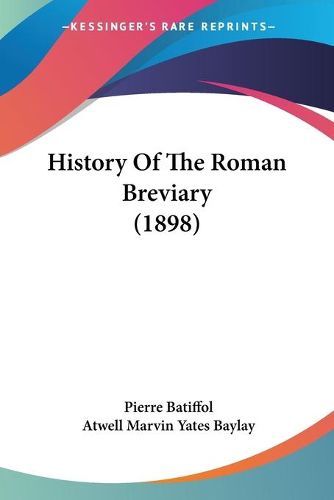Readings Newsletter
Become a Readings Member to make your shopping experience even easier.
Sign in or sign up for free!
You’re not far away from qualifying for FREE standard shipping within Australia
You’ve qualified for FREE standard shipping within Australia
The cart is loading…






Purchase of this book includes free trial access to www.million-books.com where you can read more than a million books for free. This is an OCR edition with typos. Excerpt from book: HISTORY OF THE EOMAN BUEVIAEY CHAPTER I THE GENESIS OF THE CANONICAL HOURS THEEoman canonical Office, of which the Eoman Breviary is an adaptation, dates from the end of the seventh century or the beginning of the eighth. But this Eoman canonical Office is not by any means a creation, formed in all its parts at a given date, by some Pope whose name is unknown to us. It is a composite work: various ages have contributed to it; some of the materials which find a place in it have come from far: it is like the basilica of St. Peter in the days of Pope Adrian the First. In the second chapter we shall have to analyse the materials furnished by Eome herself to this work of her canonical Office, but we have in the first place to deal with those which it owes to the common tradition of all the Churches. To Eome belong its Kalendar, its apparatus of antiphons and responds, its chant, and the actual order of its psalmody; to Catholic usage belongs the prescription of the various hours of prayer: that is to say, the principle of the Office itself, a principle whose origin and primitive developments it is important to determine, in order to be in a better position for understanding the independent application which was made of that principle by the Eoman Church. The principal element i.n the Divine Office may be, at all events conjecturally, regarded as being connected with one of the very earliest Christian ideas. Our Saviour Jesus Christ died forsaken by His own disciples, condemned by the Jews, crucified between two thieves. He rose again the third day, He ascended into Heaven; hut was that the whole of the triumph which the prophets had foretold for the Messiah, the Son of David ? No ! and what had been wanting to Him in His passage through this world, that ro…
$9.00 standard shipping within Australia
FREE standard shipping within Australia for orders over $100.00
Express & International shipping calculated at checkout
Purchase of this book includes free trial access to www.million-books.com where you can read more than a million books for free. This is an OCR edition with typos. Excerpt from book: HISTORY OF THE EOMAN BUEVIAEY CHAPTER I THE GENESIS OF THE CANONICAL HOURS THEEoman canonical Office, of which the Eoman Breviary is an adaptation, dates from the end of the seventh century or the beginning of the eighth. But this Eoman canonical Office is not by any means a creation, formed in all its parts at a given date, by some Pope whose name is unknown to us. It is a composite work: various ages have contributed to it; some of the materials which find a place in it have come from far: it is like the basilica of St. Peter in the days of Pope Adrian the First. In the second chapter we shall have to analyse the materials furnished by Eome herself to this work of her canonical Office, but we have in the first place to deal with those which it owes to the common tradition of all the Churches. To Eome belong its Kalendar, its apparatus of antiphons and responds, its chant, and the actual order of its psalmody; to Catholic usage belongs the prescription of the various hours of prayer: that is to say, the principle of the Office itself, a principle whose origin and primitive developments it is important to determine, in order to be in a better position for understanding the independent application which was made of that principle by the Eoman Church. The principal element i.n the Divine Office may be, at all events conjecturally, regarded as being connected with one of the very earliest Christian ideas. Our Saviour Jesus Christ died forsaken by His own disciples, condemned by the Jews, crucified between two thieves. He rose again the third day, He ascended into Heaven; hut was that the whole of the triumph which the prophets had foretold for the Messiah, the Son of David ? No ! and what had been wanting to Him in His passage through this world, that ro…